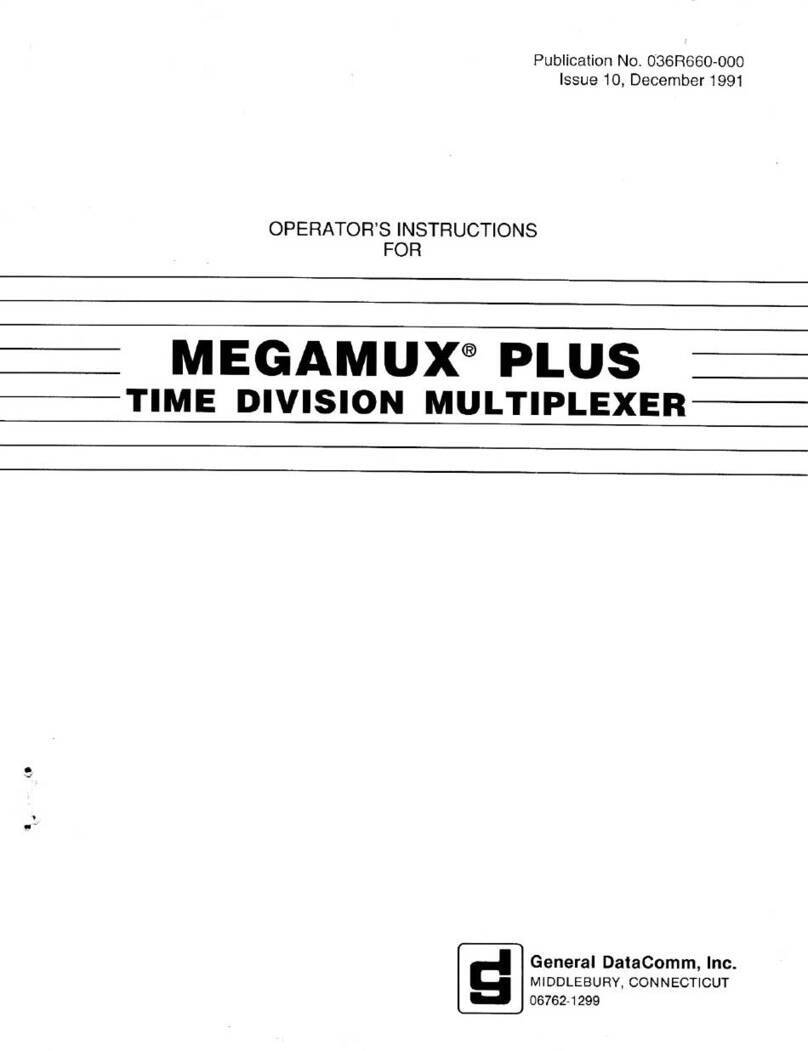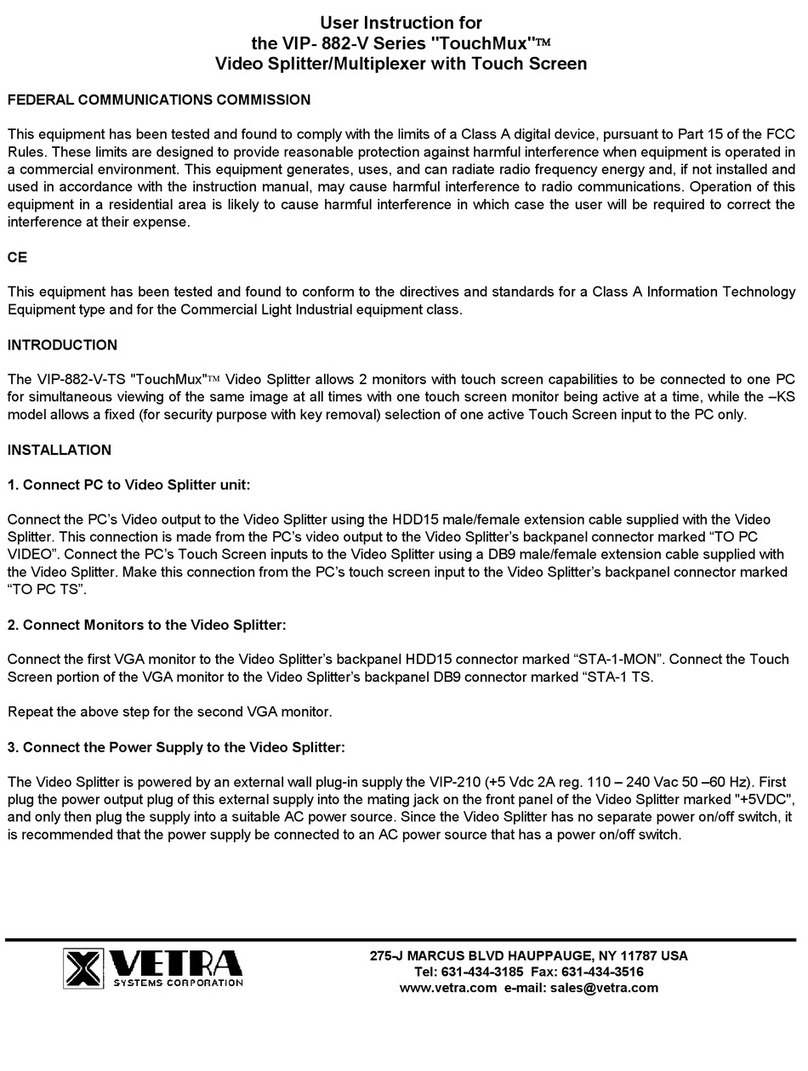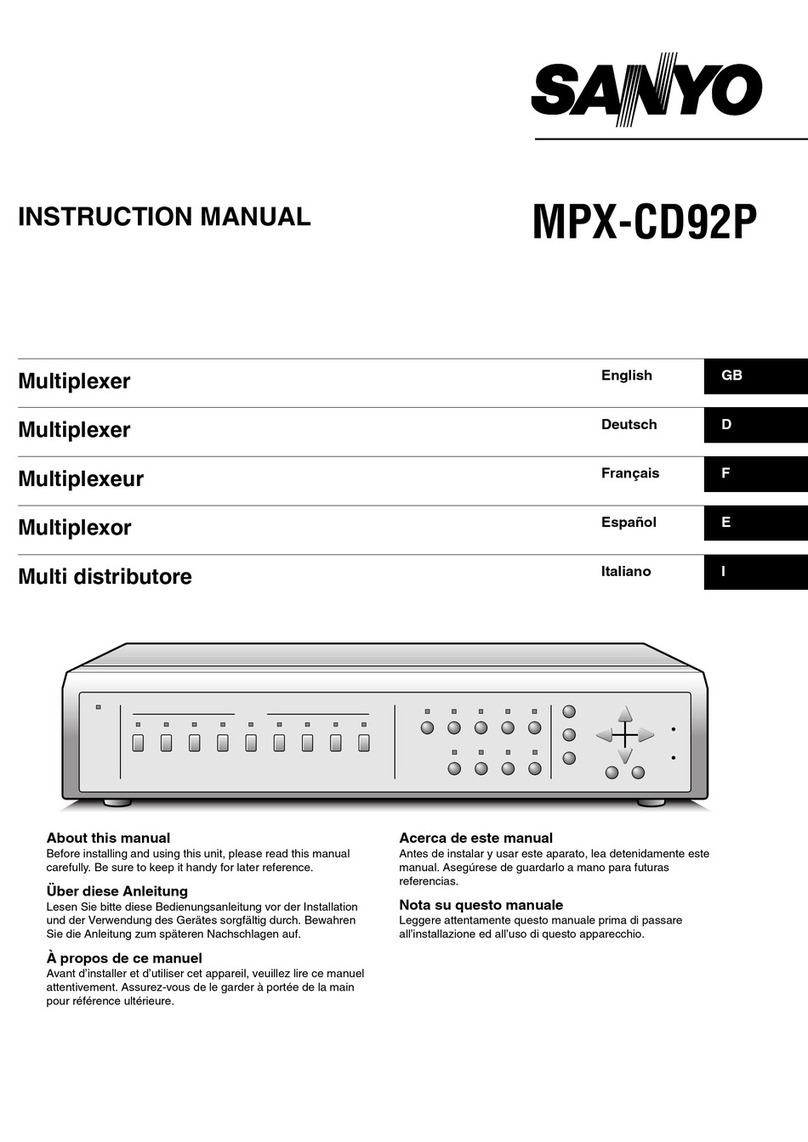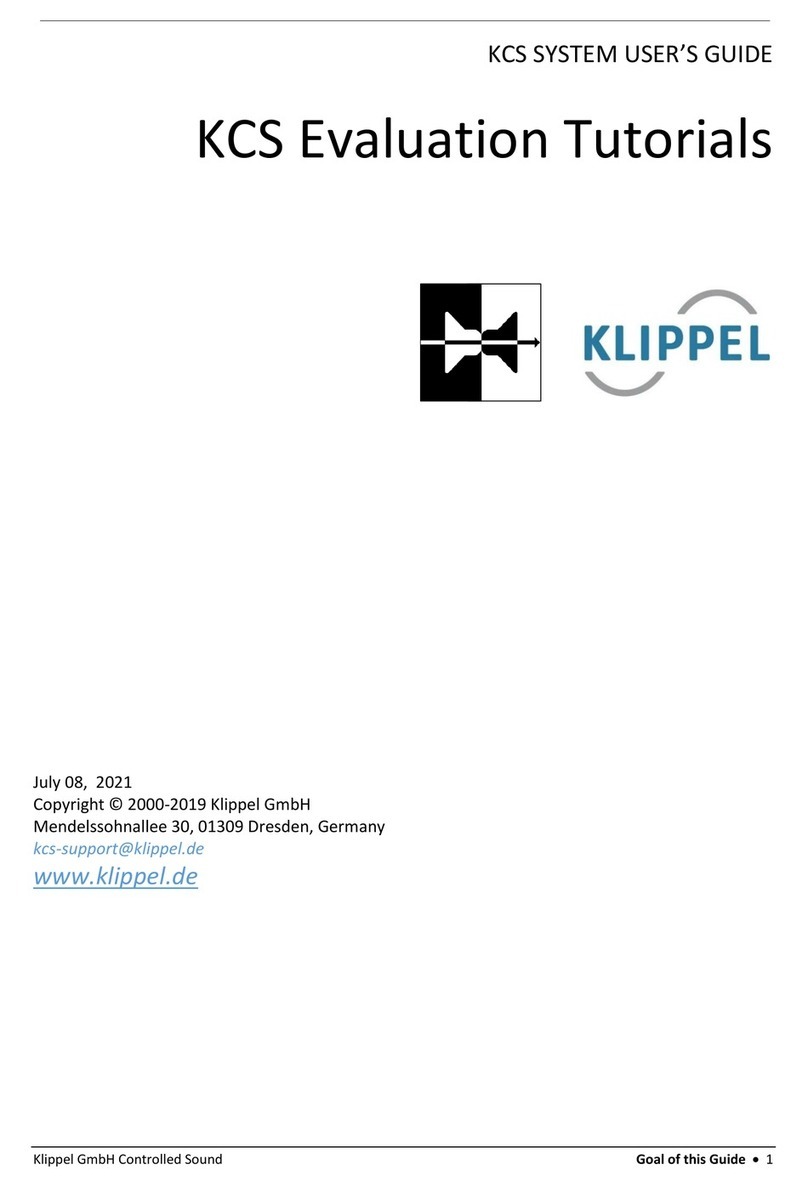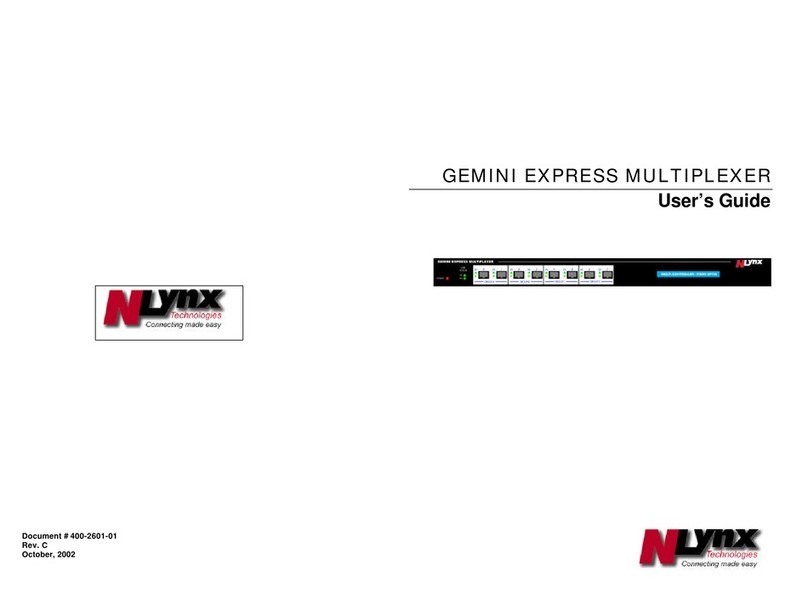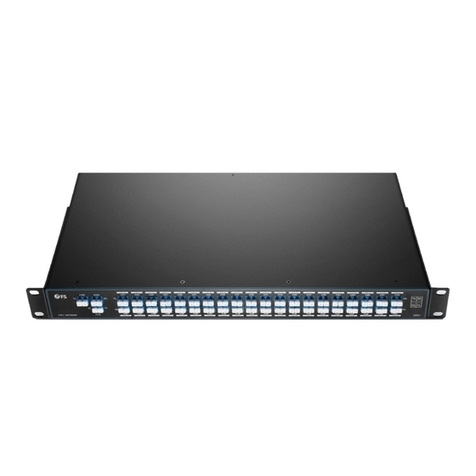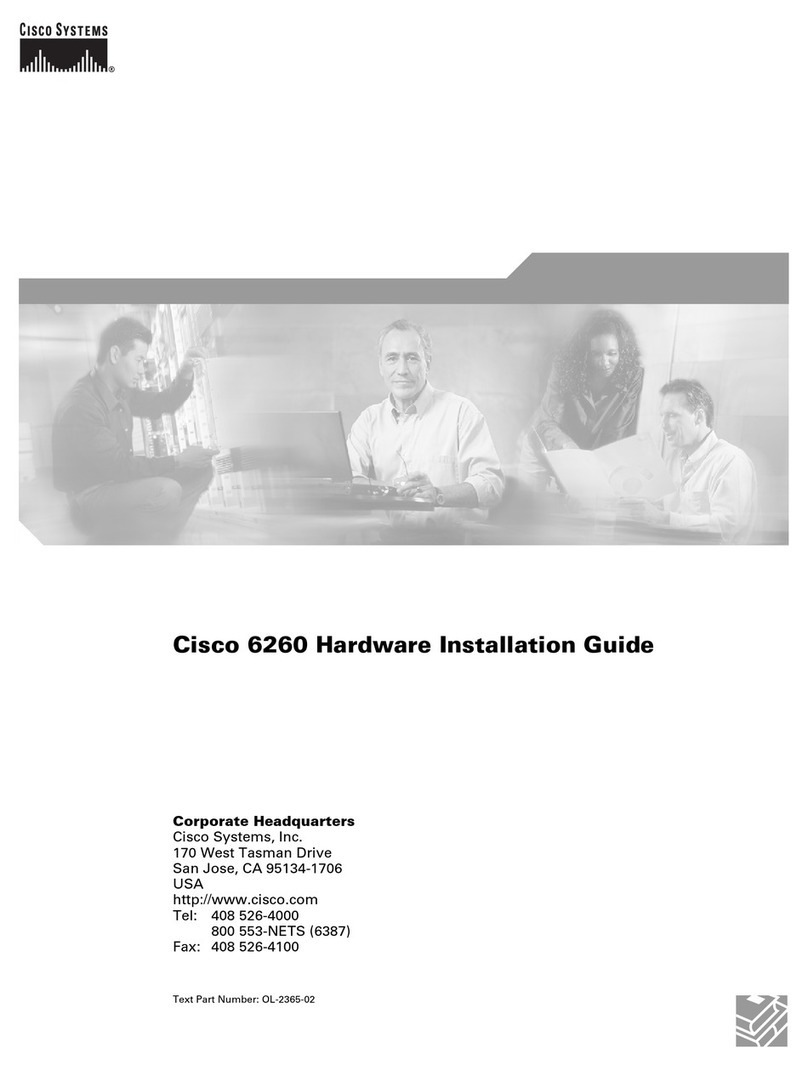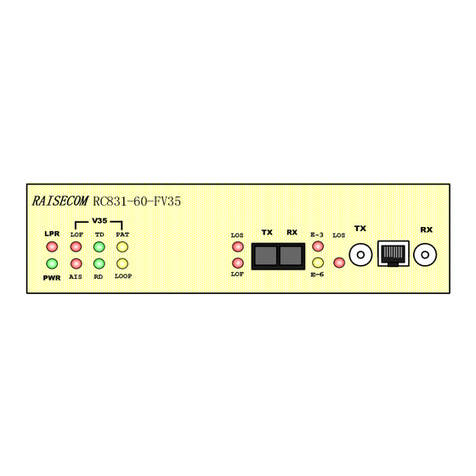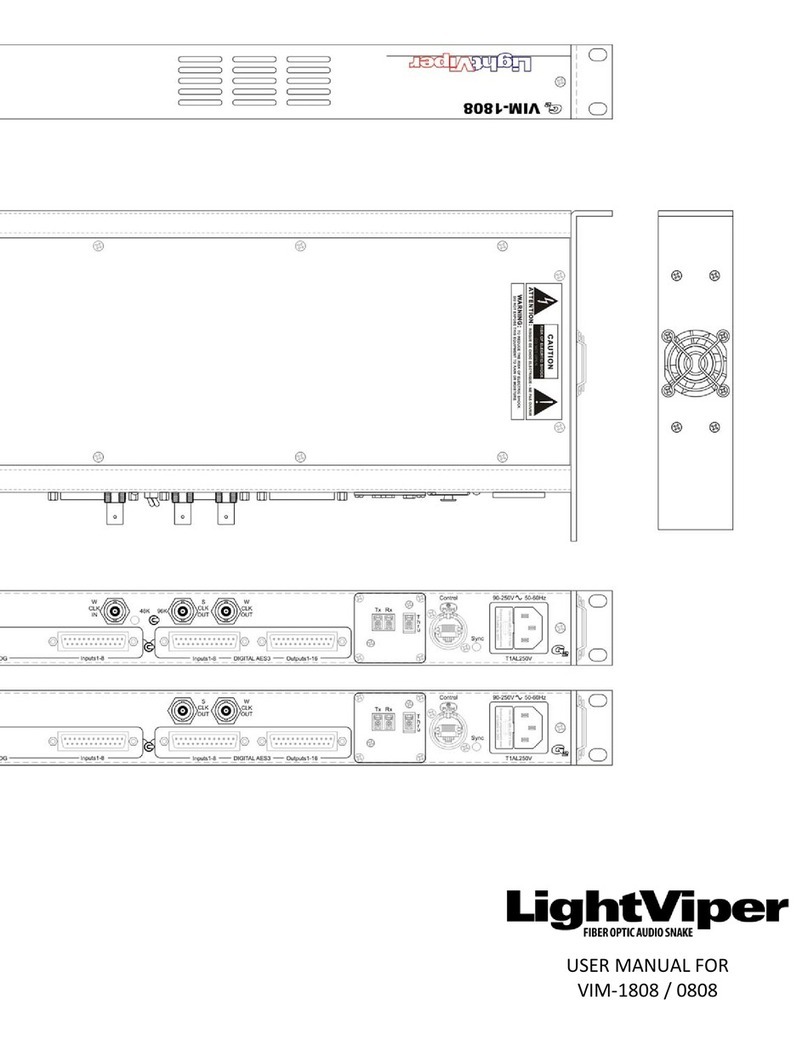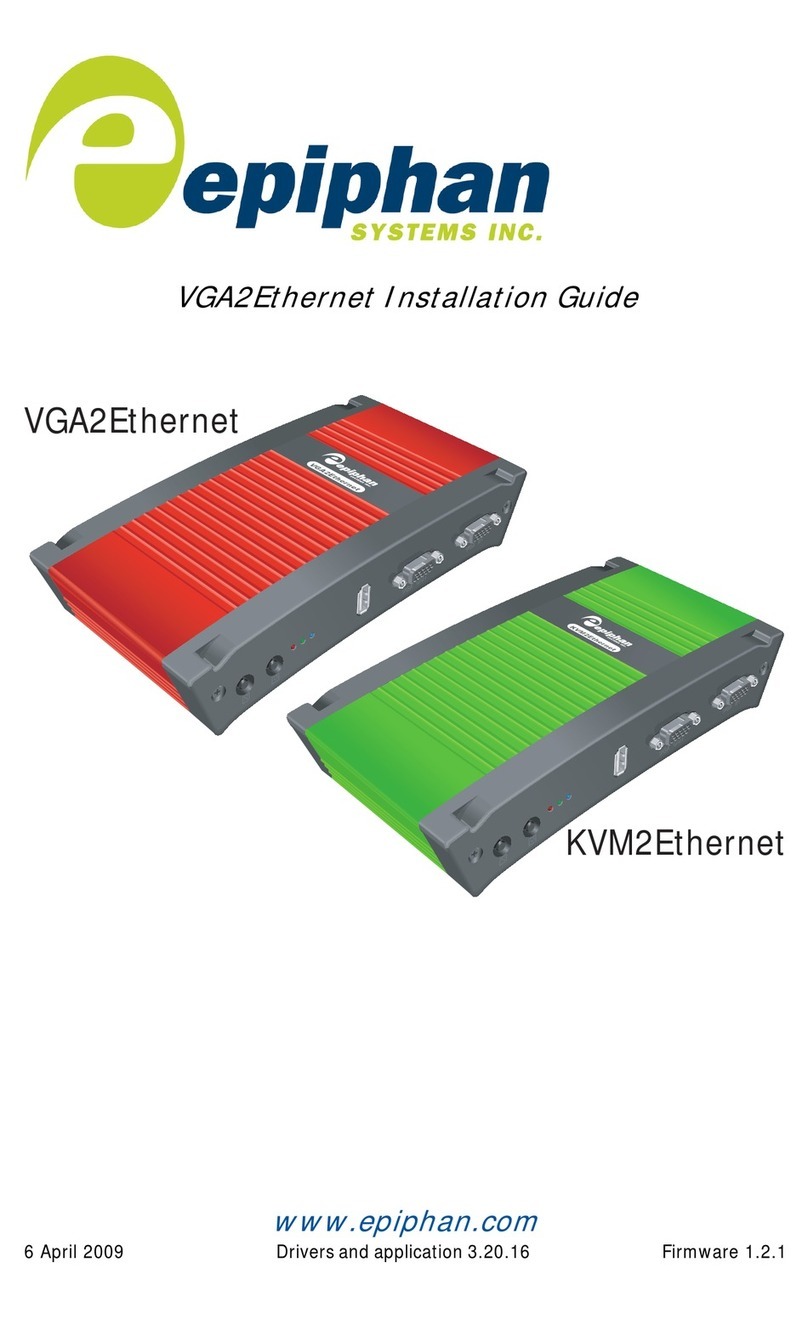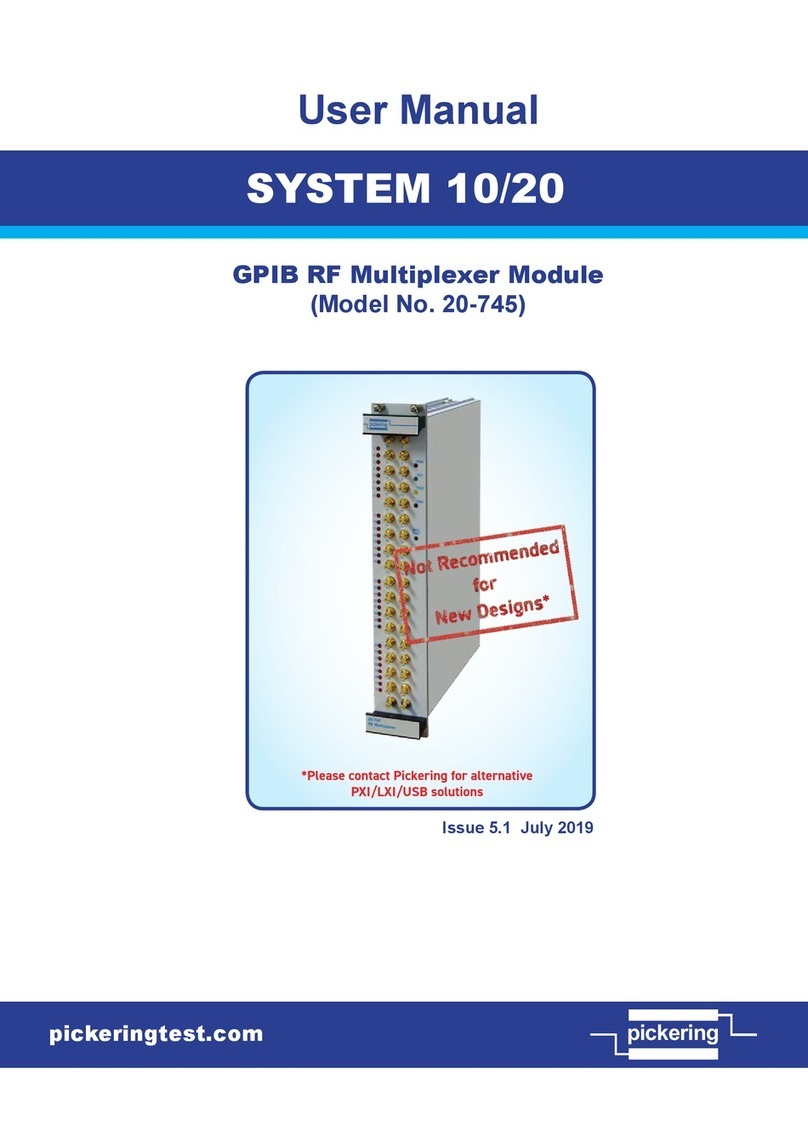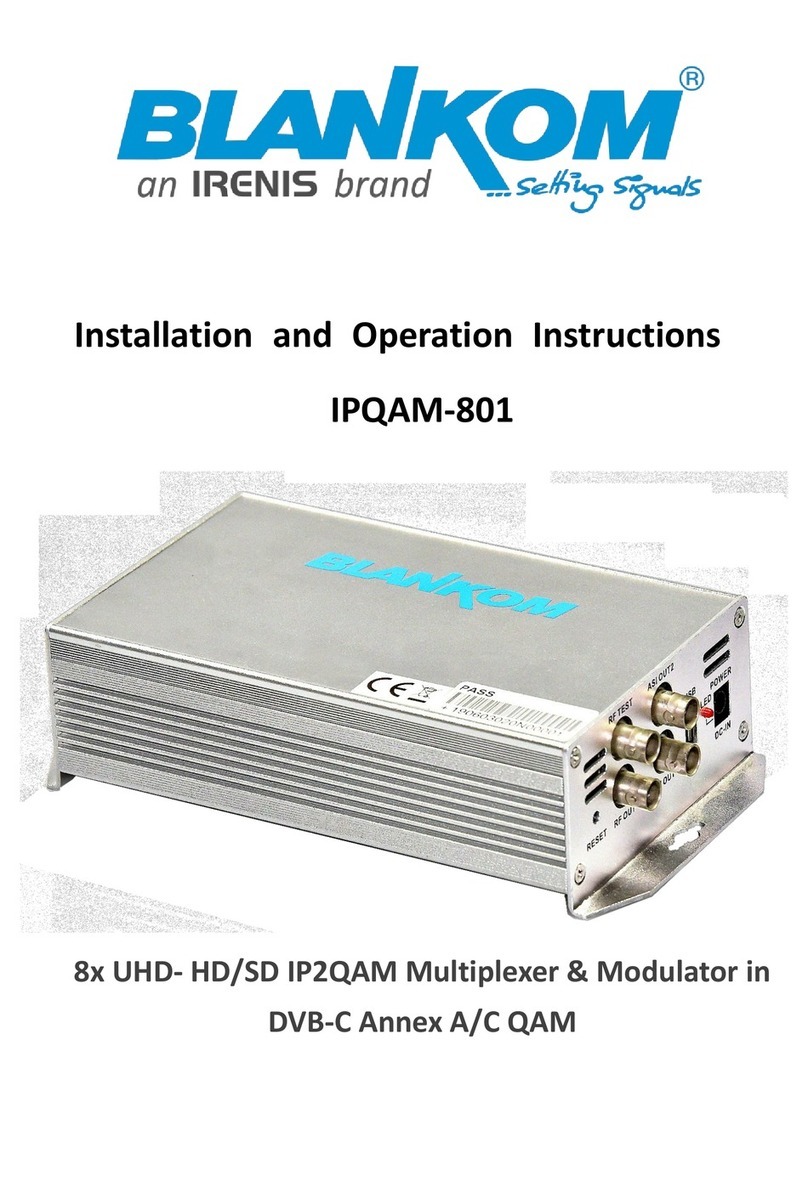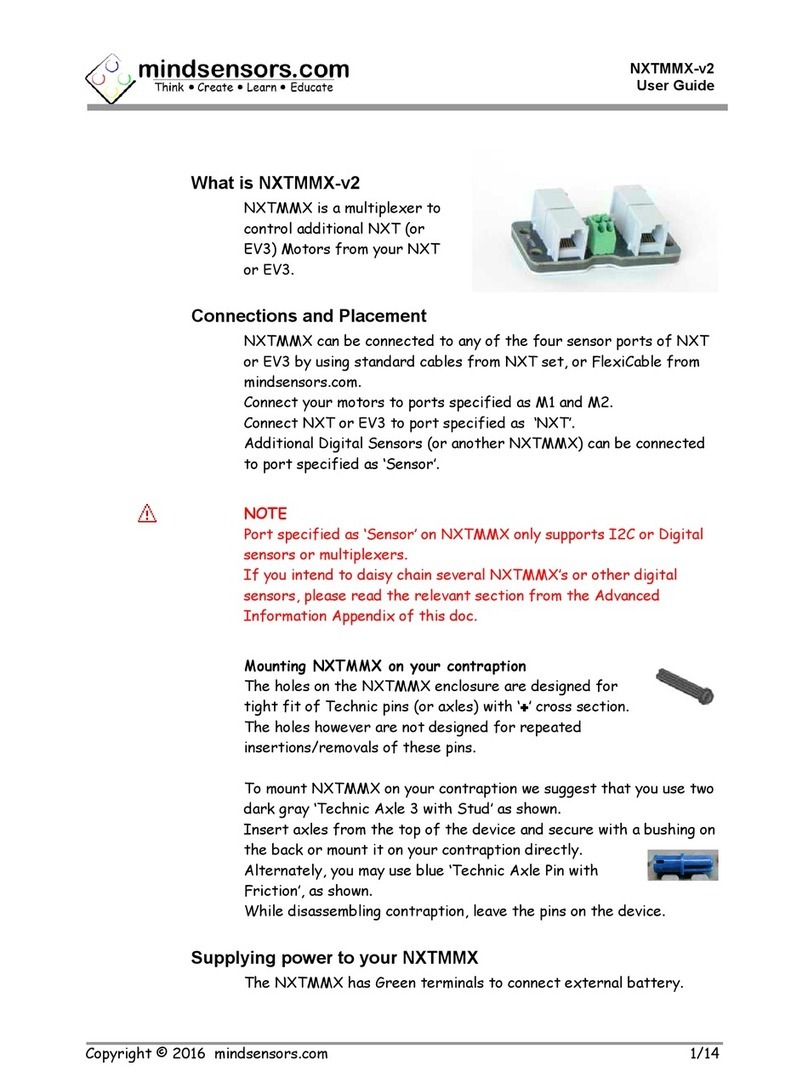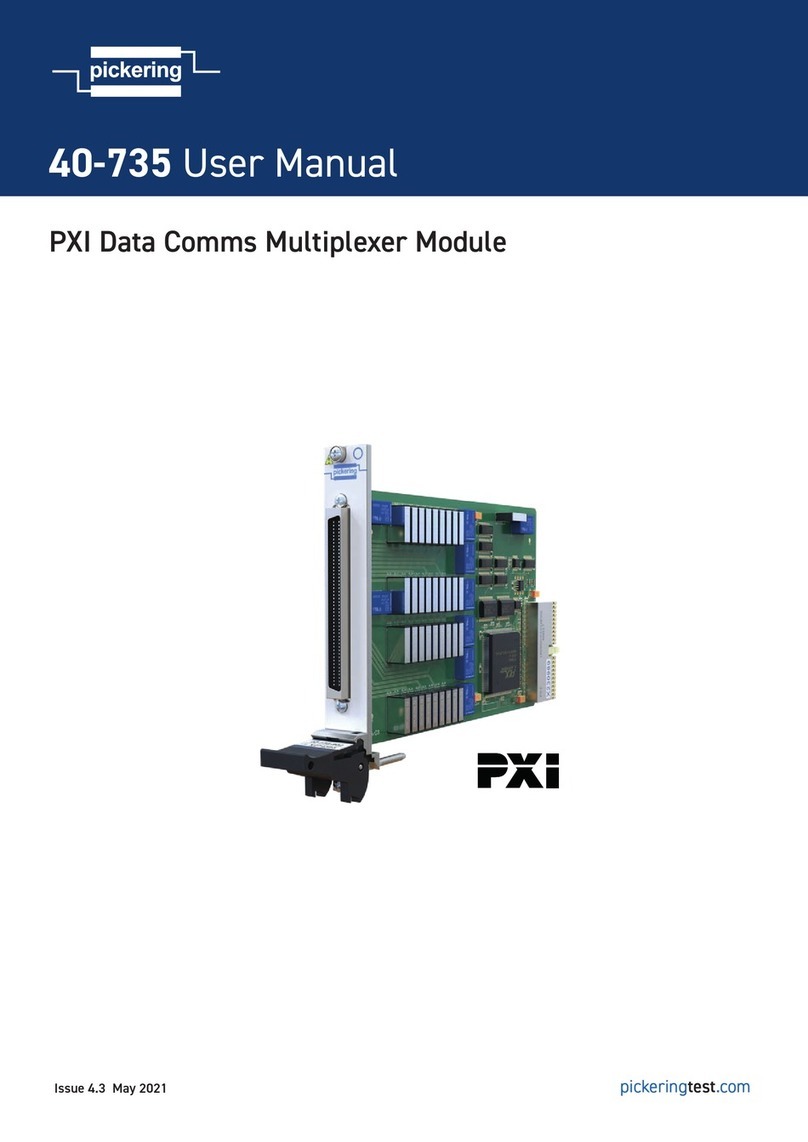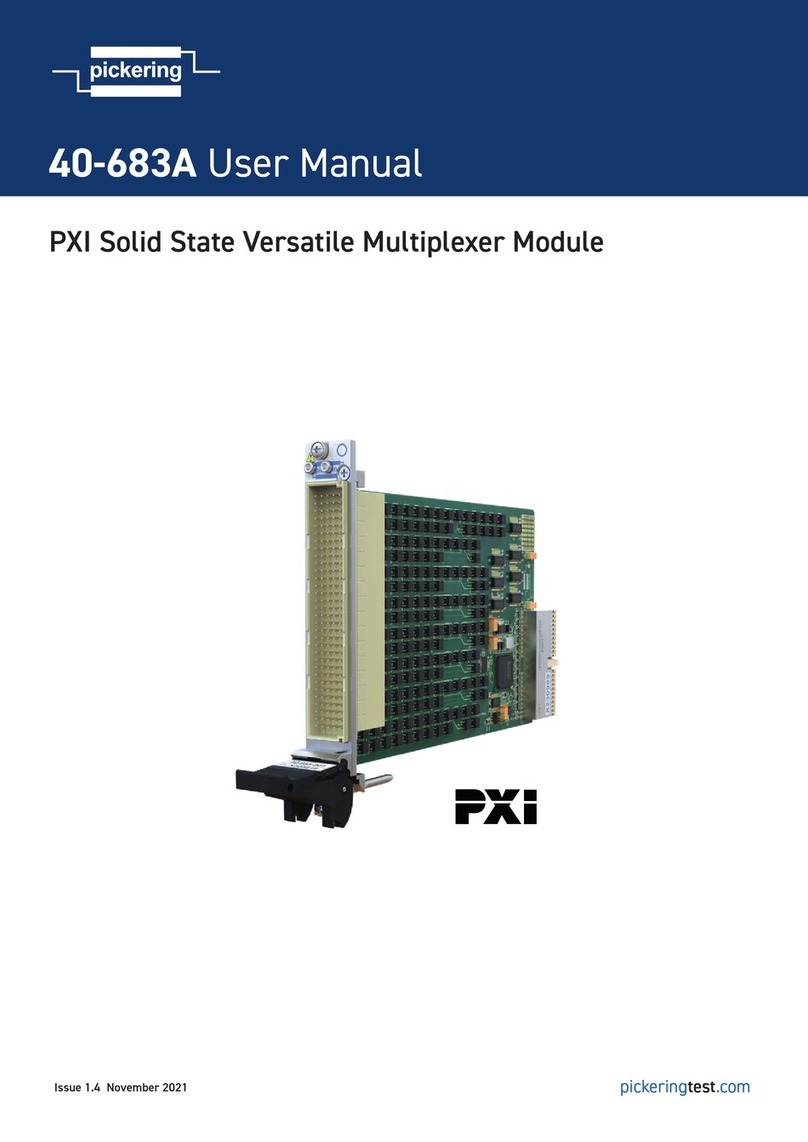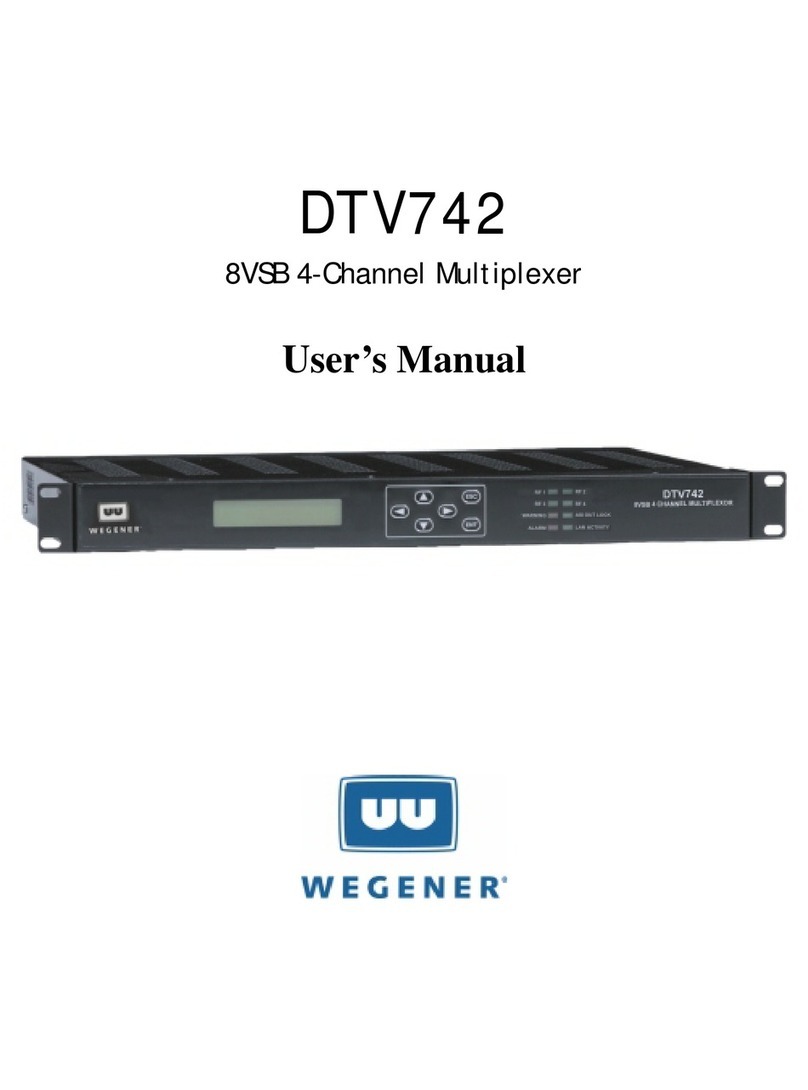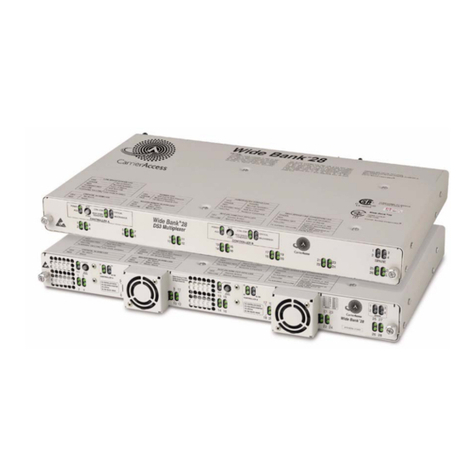General DataComm SpectraComm SRM-6 User manual

The Best Connections in the Business
General DataComm
6SHFWUD&RPP#65009#
Subrate Multiplexer
Installation & Operation Manual
076R176-000
Issue 1
June 2005

Copyright
©2005 General DataComm, Inc. ALL RIGHTS RESERVED.
This publication and the software it describes contain proprietary and confidential information. No part of this
document may becopied, photocopied, reproduced, translated or reduced to any electronic or machine-readable
format without prior written permission of General DataComm,Inc. The information in this document is subject
to change without notice. General DataComm assumes no responsibility for any damages arising from the use
of this document, including but not limited to, lost revenue, lost data, claims by third parties, or other damages.
If you have comments or suggestions concerning this manual, please contact:
General DataComm, Inc.
Technical Publications
6 Rubber Avenue
Naugatuck, Connecticut USA 06770
Telephone: 1 203 729 0271
Trademarks
All brand or product names are trademarks or registered trademarks of their respective companies or
organizations.
Documentation
Revision History for P/N 076R176-000
Related Publications
-REV is the hardware revision (-000,-001, etc.)
-VREF is the most current software version (-V600 is Version 6.0.0.)
In addition to the publications listed above, always read Release Notes supplied with your products.
Issue Number Date Description of Change
1 June 2005 Initial Release
Description Part Number
SpectraComm/UAS Shelf & Enclosure Installation and Operation Manual 010R302-REV
SpectraComm 2000 Shelf Installation and Operation Manual 010R358-REV
SpectraComm Manager Card Installation & Operation Manual 048R303-REV
SpectraComm V.F28.8/336.Modem Installation & Operation Manual 060R112-REV
SpectraComm 521A/S DDS DSU Installation & Operation Manual 076R152-REV
SpectraComm 553 T1 DSU Installation & Operation Manual 076R155-REV

076R176-000 SC SRM-6 Multiplexer i
Issue 1 Installation & Operation Manual
Table of Contents
Preface
Compliance: Pending............................................................................................................... iv
Support Services and Training.................................................................................................. v
Corporate Client Services....................................................................................................v
Factory Direct Support & Repair ........................................................................................v
Contact Information ............................................................................................................v
Chapter 1: Introduction and Specifications
SpectraComm SRM-6 Overview........................................................................................... 1-1
Intended Use.....................................................................................................................1-1
Features & Benefits..........................................................................................................1-1
Management Features.......................................................................................................1-3
Diagnostics.......................................................................................................................1-3
Maintenance .....................................................................................................................1-3
Alarms ..............................................................................................................................1-3
Timing ..............................................................................................................................1-4
SRM-6 Applications.........................................................................................................1-5
Technical Specifications........................................................................................................ 1-7
Chapter 2: Installation and Setup
Setting Card Options ........................................................................................................2-3
Installation Guidelines......................................................................................................2-4
Cable Connections............................................................................................................2-5
Connector Pinouts ............................................................................................................2-6
Front Panel Controls and Indicators...............................................................................2-10
Accessing the Shelf.............................................................................................................. 2-11
Configuring a VT-100 Terminal Connection.................................................................2-11
Configuring a Telnet Connection...................................................................................2-12
Chapter 3: SRM-6 Operation & Diagnostics
Basic Procedures ..............................................................................................................3-1
SRM-6 Configuration Menu.................................................................................................. 3-2
Aggregate Interface Configuration Screen.......................................................................3-3
Channel Interface Configuration Screen..........................................................................3-4
Aggregate Alarm Configuration Screen...........................................................................3-5
Channel Alarm Mask Configuration Screens...................................................................3-6
SRM-6 Diagnostics................................................................................................................ 3-7
SRM-6 Alarm Monitor........................................................................................................... 3-9
Interface Status Screen......................................................................................................... 3-10
SRM-6 Maintenance Screen ................................................................................................ 3-11

076R176-000 SC SRM-6 Multiplexer iii
Issue 1 Installation & Operation Manual
Preface
Scope
This manual describes how to install and operate the GDC SpectraComm SRM-6 multiplexer. The
information contained in this manual has been carefully checked and is believed to be entirely
reliable. However, as General DataComm improves the reliability, function, and design of their
products, is possible that information may not be current. Contact General DataComm if you
require updated information for this or any other General DataComm product.
General DataComm, Inc.
Technical Publications
6 Rubber Avenue
Naugatuck, Connecticut, 06770 USA
Tel: 1 203 729-0271
Safety and Precautions
The CAUTION, WARNING, and DANGER statements that appear throughout this manual are
intended to provide critical information for the safety of both the service engineer and operator,and
enhance equipment reliability. The definitions and symbols for such statements comply with ANSI
Z535.2, American National Standard for Environmental and Facility Safety Signs, and ANSI
Z535.4, Product Safety Signs and Labels, issued by the American National Standards Institute.
CAUTION indicates conditions or practices which can cause damage to equipment or loss
of data.
WARNING indicates a potentially hazardous situation which, if not avoided, may result in
minor to moderate injury. It may also be used to alert against unsafe practices
DANGER indicates an imminently hazardous situation which, if not avoided, will result in
death or serious injury.

Preface Compliance: Pending
iv SCSRM-6Multiplexer 076R176-000
Installation & Operation Manual Issue 1
Safety Guidelines
Under proper conditions, this unit will operate reliably and safely in your network. If any
component is improperly handled or installed, equipment failure or personnel hazard may occur.
Use caution and common sense when installing network wires. Use the following guidelines,
especially when unsafe conditions exist or when potentially hazardous voltages are present:
• Repairs must be performed by qualified service personnel only.
• To reduce the risk of electrical shock, do not operate equipment with the cover removed.
• Never install network jacks in a wet location unless the jack is designed for that location.
• Never touch uninsulated network wires or terminals unless the network line is disconnected
at the network interface.
• Never install network wiring during an electrical storm.
Antistatic Precautions
Electrostatic discharge (ESD) results from the buildup of static electricity and can cause computer
components to fail. ESD occurs when a person whose body contains a static buildup touches a
computer component. This product card may contain static-sensitive devices that are easily
damaged. Proper handling, grounding and precautionary ESD measures are essential. Keep parts
and cards in antistatic packaging during transport or when not in use. When handling always use
antistatic floorpads, workbenchpads and an antistatic wrist strap connected to a grounded
equipment frame or chassis. If a wrist strap is not available, periodically touch an unpainted metal
surface on the equipment. Never use a conductive tool, like a screw driver or paper clip to set
switches.
Compliance:
Pending
Part 15 Compliance (Pending)
This device complies with Part 15 of the FCC rules. Operation is subject to the following two
conditions:
1. This device may not cause harmful interference and
2. This device must accept any interference received, including interference that may cause
undesired operation.
Industry Canada Notification
Electromagnetic Compatibility
This Class A digital apparatus complies with Canadian ICES-003.
Avis D’industrie Canada
La Compatibilité d’ Eléctro-magnetique
Cet appareil numerique de la classe A est conforme a la norme NMB-003 du Canada.

Preface Support Services and Training
076R176-000 SC SRM-6 Multiplexer v
Issue 1 Installation & Operation Manual
Support Services and Training
GeneralDataCommofferstwocomprehensivecustomersupportorganizationsdedicatedtopre-and
post-sale support services and training for GDC products. Corporate Client Services and Factory-
Direct Support & Repair assist customers throughout the world in the installation, management,
maintenance and repair of GDC equipment. Located at GDC’s corporate facility in Naugatuck,
Connecticut USA, these customer support organizations work to ensure that customers get
maximum return on their investment through cost-effective and timely product support.
Corporate Client Services
Corporate Client Services is a technical support and services group that is available to GDC
customers throughout the world for network service and support of their GDC products. Customers
get thereliable supportand training required for installation, management and maintenance of GDC
equipment in their global data communication networks. Training courses are available at GDC
corporate headquarters in Naugatuck, Connecticut, as well as at customer sites.
Factory Direct Support & Repair
GDC provides regularand warranty repair services through Factory Direct Support & Repair at its
U.S. headquarters in Naugatuck, Connecticut. This customer support organization repairs and
refurbishes GDC products, backed by the same engineering, documentation and support staff used
to build and test the original product. Every product received for repair at Factory Direct Support
& Repair is processed using the test fixtures and procedures specifically designed to confirm the
functionality of all features and configurations available in the product.
As part of GDC’s Factory Direct program, all product repairs incorporate the most recent changes
and enhancements from GDC Engineering departments, assuring optimal performance when the
customer puts the product back into service. Only GDC’s Factory Direct Support & Repair can
provide this added value.
Contact Information
General DataComm, Inc.
6 Rubber Avenue
Naugatuck, Connecticut 06770 USA
Attention: Corporate Client Services
Telephones: 1 800 523-1737
1 203 729-0271
Fax: 1 203 729-3013
Email: client[email protected]m
General DataComm, Inc.
6 Rubber Avenue
Naugatuck, Connecticut 06770 USA
Attention: Factory Direct Support & Repair
Telephones: 1 800 523-1737
1 203 729-0271
Fax: 1 203 729-7964
Email: factorydirect@gdc.com
Hours of Operation:
Monday - Friday 8:30 a.m. - 5:00 p.m. EST
(excluding holidays)
http://www.gdc.com

Preface Support Services and Training
vi SCSRM-6Multiplexer 076R176-000
Installation & Operation Manual Issue 1

076R176-000 SCSRM-6Multiplexer 1-1
Issue 1 Installation & Operation Manual
Chapter 1: Introduction and
Specifications
SpectraComm SRM-6 Overview
The SpectraComm SRM-6 is a six-channel Time-Division Subrate Multiplexer that interfaces with
a SpectraComm V.F28.8/33.6 modem, aSpectraComm 521A/S DDS DSU, a SpectraComm 553 T1
DSU, or any RS-232 or RS-530 DCE device in point-to-point applications. A SpectraComm
Manager (SCM) card provides the Telnet and Ethernet connections. Field personnel can attach a
VT100/ASCII terminal to the SCM craft port to provision the SRM-6, monitor alarms and status,
and perform diagnostics and maintenance. The SCM is the SNMP proxy agent for the SRM-6 and
the modem/DSU, allowing alarm traps sent to a trap manager.
Intended Use
The SRM-6 installs in one slot of a SC 2000 low density shelf or a SC 5000 high density shelf. The
SRM-6 front panel provides LEDs that indicate operating status. The mass termination connector
at the front panel is cabled to an accessory panel which provides six EIA-232-E interfaces through
DB-25 Female connectors wired as DCE. The accessory panel mounts onto the rear of the SC 2000
shelf or can be installed at the front of the telco rack. Refer to Figure 2-2 and accompanying
paragraphs for complete front and rear panel connection instructions.
Features & Benefits
• Provides efficient, cost-effective network access for subrate applications by reducing the need
for additional communication lines and equipment.
• Combines synchronous and asynchronous data from up to six subrate users into one TDM
payload.
• Allows users’ mixed data rates in one TDM payload.
• Built-in diagnostic aggregate loopback (toward DTE)
• Alarm monitor and SNMP trap generation
• Telnet, LAN, and ASCII/VT100 craft connections
via the SCM
• Multi-level password protection for craft or Telnet management access; inactivity timers.
• Front Panel LEDs indicate operating status
• TFTP download for firmware upgrades
• Power requirements are less than 6 Watts per card.

Introduction and Specifications SpectraComm SRM-6 Overview
1-2 SC SRM-6 Multiplexer 076R176-000
Installation & Operation Manual Issue 1
Figure 1-1 Typical Installation and Front Panel Views of the SRM-6 System
Note For more information on the SCM, SpectraComm shelf systems or any companion product card, refer to the
corresponding manuals listed inside the front cover of this document.
V.F 28.8
LL
RL
DL
SEL
TXD RXD
RTS CTS
DCD GD
TM ALM
DTR OH
NR ND
ADV
ST
SCM
CTRL
SD RD
SD RD
NR ND
TM ALM
INS ON
L
A
N
W
A
N
SRM-6
INS
TM ON
AM
SYNC ET
1
2
3
4
5
6
SD RD
SC2000 Shelf 1
SC2000 Shelf 2
Management
Link
NOTE:
ForVF (digital) networks, the SC V.F 28.8 modem installs in slot 2 (shown).
For DDS networks, the SC 521A DSU installs in slot 2.
ForT1 networks, the SC 553 DSU installs in slot 2.
SCM
(Slot 1) SC V.f28.8/33.6 MODEM
(Slot 2)
SRM-6
(Slot 4)
Slot 3
(Not Used)
SRM-6
INS
TM ON
AM
SYNC ET
1
2
3
4
5
6
SD RD
SCM
CTRL
SD RD
SD RD
NR ND
TM ALM
INS ON
NR ND
L
A
N
W
A
N
V.F 28.8
LL
RL
DL
SEL
TXD RXD
RTS CTS
DCD GD
TM ALM
DTR OH
NR ND
ADV
ST
521A
ST
LT
RL
DL
INS ON
SD RD
RS CO
ICC NC
TMG RSP
TYPICAL INSTALLATION
(Shown with SC V.F28.8/33.6 Modem in Slot 2)
FRONT PANEL
VIEWS Slot 1
SCM Slot 4
SRM-6
Slot 2
Modem,
DDS DSU
or T1 DSU
L
I
N
E
I
N
O
U
T
M
O
N
RSP
SD RD
EQ
BPV AIS
OOF NS
T1
CH
RL
553

Introduction and Specifications SpectraComm SRM-6 Overview
076R176-000 SC SRM-6 Multiplexer 1-3
Issue 1 Installation & Operation Manual
Management Features
The SpectraComm Manager card provides craft, Telnet, and LAN connections for SRM-6
communication,monitoring, and management functions. These functions are accessed viathe SCM
front panel EIA-232 craft (CTRL) port, the rear panel DB25F LAN port, and the rear panel RJ45
WAN/DBU WAN ports.
Discovery via the SCM
The SCM card performs network discovery of the SRM-6. The discovery function identifies
compatible network elements located in the SpectraComm shelf and stores element information in
its local database. Information includes the element type, configuration checksum, serial number,
alarm status, and equipment status. The user can access this information by means of the SCM
Management Information Base (MIB).
Alarms and Traps
After the initial Discovery, the SCM card polls the active slot addresses for alarms and statistical
data on network elements and also polls one inactive slot. By reducing the frequency at which it
polls inactive slots, the SCM card can continuously monitor as rapidly as possible and still discover
newly installed SCM-compatible equipment. The SCM communicates continually with the
SRM-6 and forwards its alarm traps to a designated controller.
Note Refer to the SCM Installation and Operation Manual for additional information on the communication,
discovery, trap forwarding, and management functions provided for the SRM-6.
Diagnostics
SRM-6 provides an aggregate loopback diagnostic test that can be initiated at the SCM craft port or
via a Telnet connection. This test loops aggregate Transmit Data from the DTEs to Receive Data to
the DTEs.
Maintenance
Maintenance features include menu-driven commands for Soft Reset, Load Factory Defaults, and
Firmware Download.
Alarms
SRM-6 Channel Alarms (one for each channel) include No RTS and No Remote CTS.
SRM-6 Aggregate Alarms include No DCD, No Frame Sync, and No Remote Frame Sync.
All Channel and Aggregate alarms can be configured as Masked, or Reported.

Introduction and Specifications SpectraComm SRM-6 Overview
1-4 SC SRM-6 Multiplexer 076R176-000
Installation & Operation Manual Issue 1
Timing
In 4-wire, leased private line modem applications that useaggregate datarates of19.2, 28.8, or 33.6
Kbps, the SRM-6 gets its transmit timing from the SC V.F28.8 modem or one of the DTEs. One
modem is configured for Internal or External transmit timing, with the modem on the other side
configured forReceive transmit timing. InDDS network applications requiring aggregate data rates
of 56 and 64 Kbps, the SRM-6 gets its transmit timing from the DSU that is configured for Receive
transmit timing.
Note For more information on configuring transmit timing in the modem or DSU, refer to the corresponding
manual listed inside the front cover of this document.
Figure 1-2 Terminal Timing in a SRM-6 System
4-Wire Leased
Private Line
DTE
SRM-6
MODEM
REMOTE SITE
Chan. 1
Channel 1
Tx Clock
set to TT
(Pin 24)
External
Timing
(Pin 24)
Aggregate
Tx Clock set to
Channel 1 TT
(Pin 15)
Aggregate
Tx Clock
set to ST
SRM-6
DTE
Chan. 1
Channel 1
Tx Clock
set to ST
Receive
Timing
Provides
Clock
CENTRAL SITE
MODEM
Receive
Timing (Pin 15)

Introduction and Specifications SpectraComm SRM-6 Overview
076R176-000 SC SRM-6 Multiplexer 1-5
Issue 1 Installation & Operation Manual
SRM-6 Applications
4-Wire Private Line Modem Application
The SRM-6 multiplexer is shown below in a typical 4-wire private line modem application with the
SC V.F28.8 modem and the SCM. On the DTE side, the SRM-6 actsas a DCE, multiplexing up six
DTEs into one aggregate. On the DCE side of the SRM-6, communication with the co-located
modem is configured to one of three aggregate data rates: 19.2, 28.8, or 33.6 Kbps. Local and
remote sites are connected via the 4-wire, leased private line. Management is conducted via a craft
or LAN/Telnet connection to the SCM.
Figure 1-3 SRM-6 Multiplexing in a Private Line Modem Application
DDS Network Application
The SRM-6 multiplexer is shown below in a typical DDS application with the SC 521A/S DSU and
the SCM. Onthe DTE side, the SRM-6actsas a DCE, multiplexing up six DTEs intoone aggregate.
On the DCE side of the SRM-6, communication with the co-located DSU is configured to one of
two aggregate data rates: 56or 64 Kbps. Local and remotesites are connectedover the4-wire, DDS
line. Management is conducted via a craft or LAN/Telnet connection to the SCM.
Figure 1-4 SRM-6 Multiplexing in a Typical DDS Network
LOCAL SITE
4-Wire Leased
Private Line
DTE 1
DTE 2
DTE 3
DTE 4
DTE 5
DTE 6
SRM-6 MUX SC V.F28.8
MODEM
SCM
REMOTE SITE
SRM-6 MUX
SC V.F28.8
MODEM
SCM
Up to
6 DTEs
OR
Craft
Telnet
SNMP
OR
Craft Telnet
SNMP
RS-232 or
RS-530
RS-232
Up to
6 DTEs
DDS
Network
LOCAL SITE
DTE 1
DTE 2
DTE 3
DTE 4
DTE 5
DTE 6
SRM-6 MUX
SCM
REMOTE SITE
SRM-6 MUX
SCM
OR
Craft
Telnet
SNMP
OR
Craft Telnet
SNMP
RS-232 or
RS-530
RS-232
SC 521A/S
DDS DSU SC 521A/S
DDS DSU

Introduction and Specifications SpectraComm SRM-6 Overview
1-6 SC SRM-6 Multiplexer 076R176-000
Installation & Operation Manual Issue 1
T1 Network Application
The SRM-6 multiplexer is shown below in a typical T1 application with the SC553 DSU and the
SCM. On the DTE side, the SRM-6 acts as a DCE, multiplexing up six DTEs into one aggregate.
On the DCE side of the SRM-6, communication with the co-located DSU is configured to one of
two aggregate data rates: 56 or 64 Kbps. Local and remote sites are connected over the 4-wire, T1
line. Management is conducted via a craft or LAN/Telnet connection to the SCM.
Figure 1-5 SRM-6 Multiplexing in a Typical T1 Network
Up to
6 DTEs
T1
Network
LOCAL SITE
DTE 1
DTE 2
DTE 3
DTE 4
DTE 5
DTE 6
SRM-6 MUX
SCM
REMOTE SITE
SRM-6 MUX
SCM
OR
Craft
Telnet
SNMP
OR
Craft Telnet
SNMP
RS-232 or
RS-530
RS-232
SC 553
T1 DSU SC 553
T1 DSU

Introduction and Specifications Technical Specifications
076R176-000 SC SRM-6 Multiplexer 1-7
Issue 1 Installation & Operation Manual
Technical Specifications
The following table describes the physical, operational, and environmental specifications for the
SpectraComm SRM-6. Conforming to these specifications ensures maximum system performance
and reduces the chances of mechanical breakdown and personnel hazard.
Special Considerations
• Channel data rate of 1200 Kbps not available for aggregates rates of 56 or 64 Kbps.
• Channel data rate of 19200 Kbps not available for aggregate rate of 19.2 Kbps.
Table 1-1 SpectraComm SRM-6 Card Specifications
Specification Description
Operating Mode Point-to-Point, Full Duplex
Channel Data Rates Async or Sync: 1200, 2400, 4800, 9600, 19200 Kbps
Aggregate Data Rates Synchronous: 19.2, 28.2, 33.6, 56, or 64 Kbps
Aggregate Interfaces RS-232-E, RS-530 (wired as DTE)
Channel Interfaces RS-232-E (Channels 1 through 6 wired as DCE)
Channel Async Character Format 8 - 11 bits
Channel Async Overspeed 1%
TDM Framing Format Proprietary
Alarm Reporting Aggregate: No DCD, No Frame Sync, No Remote Frame Sync
Channel: No RTS, No Remote CTS
Tx Timing Channel:
DCE Send Timing (ST) or DTE Terminal Timing (TT)
Aggregate:
Derived from any channel, or Aggregate ST
Diagnostics Aggregate loopback to DTE
Physical Dimensions Width: 178 mm (7.0 in.)
Height: 21 mm (0.81 in.)
Depth: 241 mm (9.5 in.)
Weight: 0.28 kg (10 oz.)
Shipping weight: 0.74 kg (1 lb 10 oz)
Power Consumption Less than 6 Watts
Non-operating Temperature -40 to 70 degrees C (-40 to 158 degrees F)
Operating
Temperature 0 to 50 degrees C (32 to 122 degrees F)
Derate by one degreeC/1000 feet above sea level.
Operating Humidity 5% - 95% Relative Humidity, non-condensing
Non-operating Altitude 0 m to 12,191 m (0 ft. to 40,000 ft.)
Operating Altitude 0 m to 3,047 m (0 ft. to 10,000 ft.)
Compliance Part 15 (Pending)

Introduction and Specifications Technical Specifications
1-8 SC SRM-6 Multiplexer 076R176-000
Installation & Operation Manual Issue 1

076R176-000 SC SRM-6 Multiplexer 2-1
Issue 1 Installation & Operation Manual
Chapter 2: Installation and Setup
Installation Overview
This chapter describes setting options and installing the SRM-6 card and the two companion cards
(SCM and modem or DSU). These devices are intended for rack-mount installation in two linked
SC2000 shelves, or in any slot of the SC 5000 shelf. For more information on these SpectraComm
shelf systems, refer to the manuals listed on the inside front cover of this manual.
Unpacking Instructions
Device cards are shipped in shock-absorbent packing within a corrugated box. Table 2-1 and
Table 2-2 list the standard and optional equipment andshelf systems. Somecomponents will not be
required/supplied foryour network installation. Remove each component from the box and perform
a thorough inspection. If any component appears damaged, contact the shipper immediately. All
damaged components must be retained until an inspection by the shipper has been completed. If it
is necessary to re-package and return the unit, use the original box and packing material.
Table 2-1 Equipment Checklist
Item Description Part Number
SRM-6 SpectraComm Subrate Multiplexer Card 076P054-001
SCM SpectraComm Manager Card (Firmware Ver 5.91 or higher) 058P150-002
SC V.F28.8/33.6 SpectraComm V.F28.8/33.6 Switched Network/Private Line Card 060M012-001
SC 521A/S SpectraComm 521A/S DDS Data Service Unit 076P028-001
SC 553 SpectraComm 553 T1 Data Service Unit 076M016-010
SpectraComm 553 T1 Data Service Unit with Cascade 076M016-011
Filler Panel Blank panel used to cover unused cards slots in the shelf 010P142-001
DCE Cable RS232/530 Shielded straight-thru male to male (mux to modem/DSU) 028H502-005
DTE Cable RS232 shielded straight-thru male to male (DTEs to DTE Access Panel) 028H502-XXX
DTE Cable RS232 shielded straight-thru male to female (DTEs to DTE Access Panel) 028H506-XXX
DTE Cable 64-pin amp type Telco to blunt end 021H700-XXX
DTE Access Panel Rear-mounting SC 2000 shelf patch panel
(SRM-6 to six female DB25 connectors) 010B048-002
DTE Access Panel Front mounting SC 2000/SC 5000 shelf patch panel
(SRM-6 to six female DB25 connectors) 010B048-003
LAN Cable SCM LAN 10BaseT 029H209-001
Craft Cable RJ-45 to RJ-45, local control (SCM CTRL port): 7’, 14’ or 25’ 830-128-807
Mngt Link Cable 3-pin share jumper (Shelf-to-shelf management link) 024H218-001
Adapters DB9F to RS561 8-pin modular jack (SCM to PC terminal) 029H211-001
RS232-RS561 DB25 male to RJ45 (SCM to PC terminal) 029H210-001

Installation and Setup
2-2 SC SRM-6 Multiplexer 076R176-000
Installation & Operation Manual Issue 1
Table 2-2 SpectraComm Shelf Systems
Item Description Part Number
SC 2000 Low
Density Shelf
(2 Req’d)
SpectraComm 2000 Shelf, 2 slots 010B226-001
SpectraComm 2000 Shelf, 2 slots (Redundant power) 010B226-002
SC5000 High
Density 16-slot
Shelves
MS-2 Mod. 1, Dual Modular (100/120 Vac)
MS-2 Shelf 100/120 Vac GPS-11 Power Supply
Z1-S-16DRJ45, 8-Slot Dual RJ45 (2)
Z3-S-16DB25, 16-Slot DB25
Blank Panel, Power Supply
010M054-001
010B150-001
035P034-001
010C342-001
010C339-001
010D727-001
MS-2 Mod. 2, Dual Modular (-48, 60 Vdc)
MS-2/DC Shelf -48, 60 Vdc DPS-11 Power Supply
Z1-S-16DRJ45, 8-Slot Dual RJ45 (2)
Z3-S-16DB25, 16-Slot DB25
Blank Panel, Power Supply
010M055-001
010B152-001
041P050-001
010C342-001
010C339-001
010D727-001
MS-2 Mod. 3, Dual Modular (220/240 Vac)
MS-2E Ac Export Shelf (220/240 Vac) GPS-11E Power Supply
Z1-S-16DRJ45, 8-Slot Dual RJ45 (2)
Z3-S-16DB25, 16-Slot DB25
Blank Panel, Power Supply
010M056-001
010B151-001
035P034-002
010C342-001
010C339-001
010D727-001
MS-2 Mod. 10, Dual Modular (-48, 60 Vdc, redundant P.S.)
MS-2/DC Shelf -48 - 60 Vdc DPS-11 Power Supply
Z1-S-16DRJ45, 8-Slot Dual RJ45 (2)
Z3-S-16DB25, 16-Slot DB25
010M070-001
010B152-001
041P050-001
010C342-001
010C339-001

Installation and Setup
076R176-000 SC SRM-6 Multiplexer 2-3
Issue 1 Installation & Operation Manual
Setting Card Options
The SRM-6 has four user-configurable option jumpers, X3, X4, X5 and X6, which configure the
DB-25 aggregate interface at the rear of the shelf for RS-232 or RS-530 mode. Figure 2-1 shows
jumper locations and the default RS-232 setting. Note that option jumper X7 is reserved for future
use and will not affect SRM-6 operation.
Note Refer to the corresponding manuals to set card options for the companion cards.
Figure 2-1 SRM-6 Option Jumpers
076P054-601 SRM-6
INS
TM ON
AM
SYNC ET
1
2
3
4
5
6
SD RD
RS232
X3
530
RS232
X4
530
RS232
X5
530
RS232
X6
530
X7

Installation and Setup
2-4 SC SRM-6 Multiplexer 076R176-000
Installation & Operation Manual Issue 1
Installation Guidelines
Two SC2000 shelves or one SC5000 shelf with three available slots are required for installing the
SRM-6 and its companion cards. Either shelf can be mounted in 19-inchor 23-inchwide equipment
racks. Shelves should be installed in a ventilated area where the ambient temperature does not
exceed environmental specifications (see Table 1-1). Do not install device cards directly above
equipment that generates a large amount of heat (such as power supplies).
SC 5000 Installation
Install the cards in any slot of the SC 5000 shelf, then install the Access Panel directly below the
shelf at the front of the telco rack.
SC 2000 Installation
• The SCM card and the modem (or DSU) card must be installed in slot 1 and slot 2 of
SC 2000 Shelf #1. The SCM and the modem (or DSU) must be installed in the same shelf.
• The SRM-6 card must beinstalled in slot 3or slot 4of SC2000 Shelf#2 (seeFigure1-1). Install
a blank panel in the empty slot. Do not use the empty slot.
• The backplanes of the two SC2000 shelves must be linked by the management cable. When
properly cabled (see Figure 1-1 and Table 2-6), the SCM will control the multiplexer and the
modem (or DSU).
• A craft connection can be made to any of the devices via the SCM front panel CTRL port.
• Attach the Access Panel to the rear of the SC2000 shelf or at the front of the Telco rack, with
the two SC2000 shelves installed directly above it.
Note Additional cable and connectivity options for the SCM, modem and DSU devices are described in their
respective installation/operation manuals.
Note Refer to the latest issue of the SC2000 Shelf Manual (GDC P/N 010R358-000) or the SC5000 Shelf manual
(GDC P/N 010R302-000) for detailed information on the particular shelf and its back panel connections.
Installing Product Cards
IMPORTANT: When using SC 2000 shelves, the SRM-6, the SCM and the modem (or DSU) must
be installed in the correct slots as described above, with a blank panel in the empty slot.
1. Align the card with the inside guides of the slot in the SC2000 shelf, with the GDC logo to the
right. For the SC5000 shelf, position the card in the slot with the GDC logo at the top rail.
2. Insert the card until it makes contact with the backplane connectors.
3. Pull down the insertion/extraction tab on the front panel firmly push the card in until it seats
firmly in the backplane connectors.
4. Perform setups and pre-operation checks in their entirety as described in the product manual.
5. To remove a card, pull the front panel insertion/extraction tab to unseat the card, then use the
tab to remove card.
6. Perform the cabling and connection procedures in their entirety, as described in this chapter.
This manual suits for next models
1
Table of contents
Other General DataComm Multiplexer manuals

